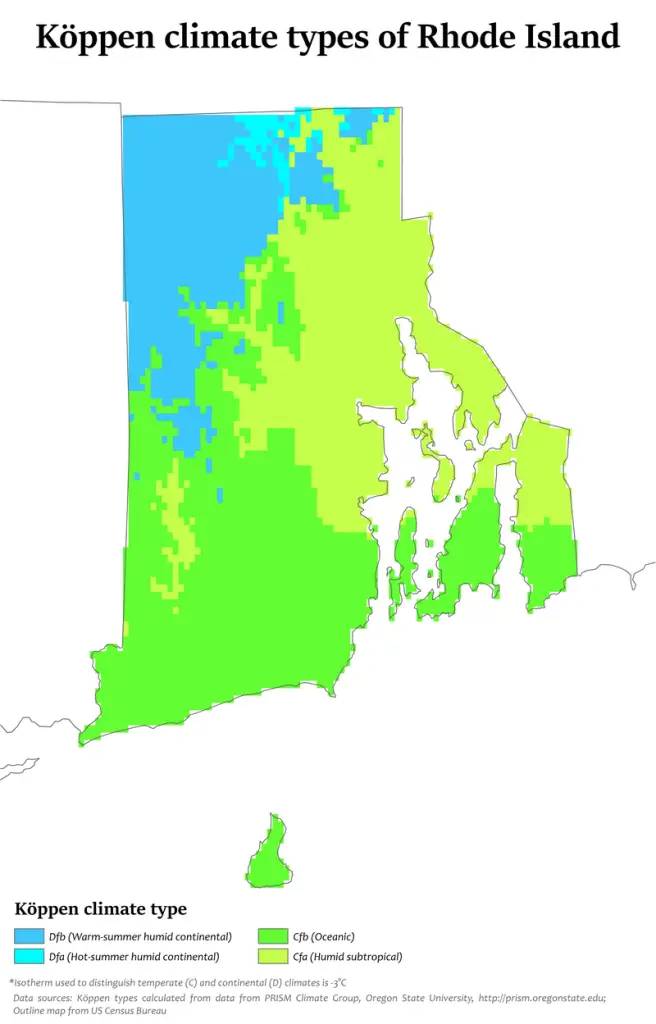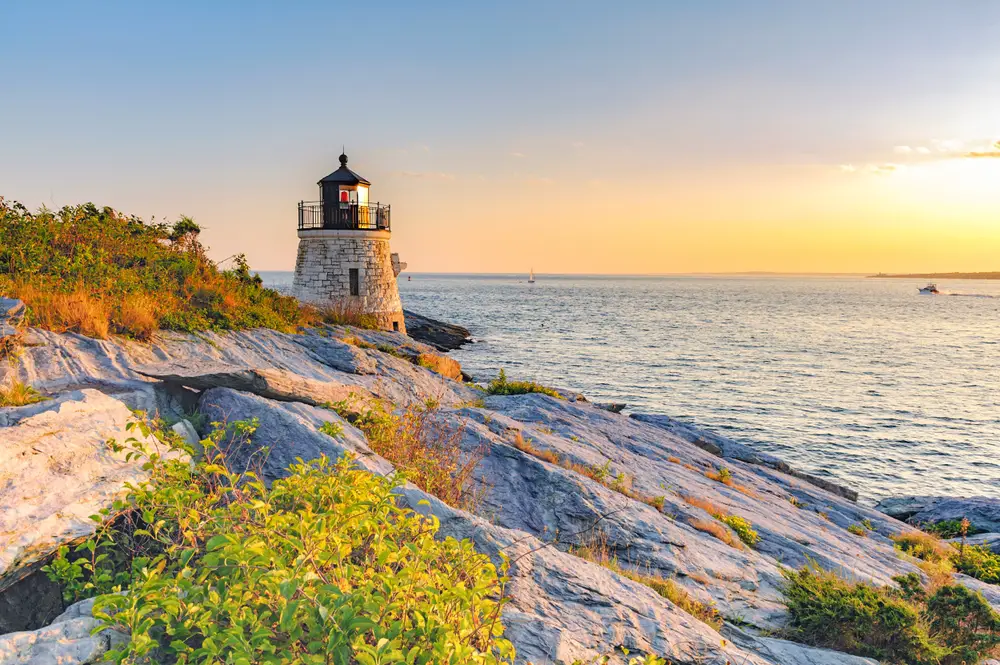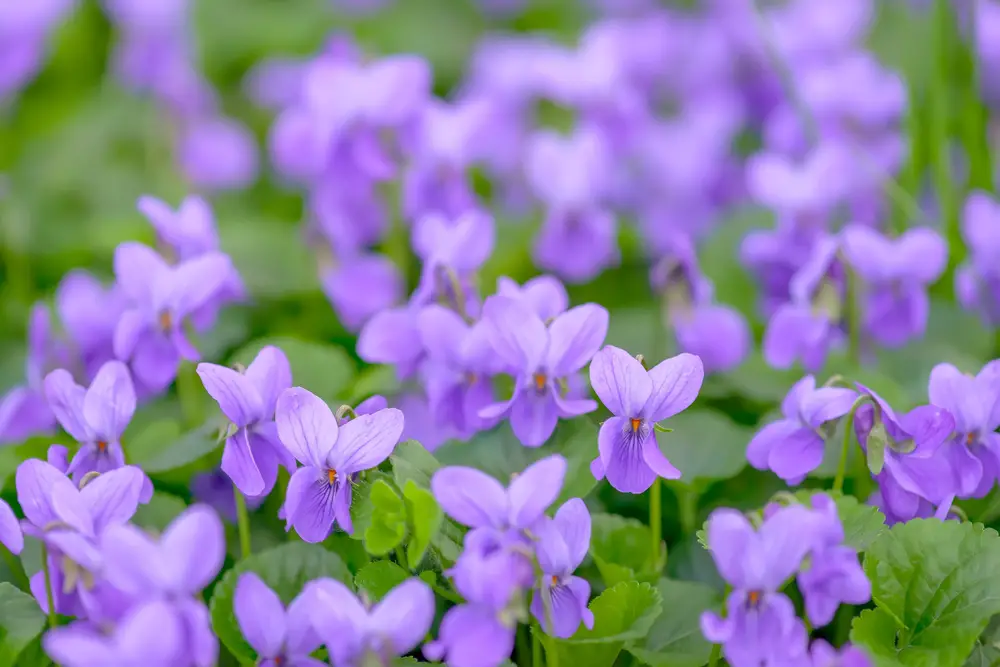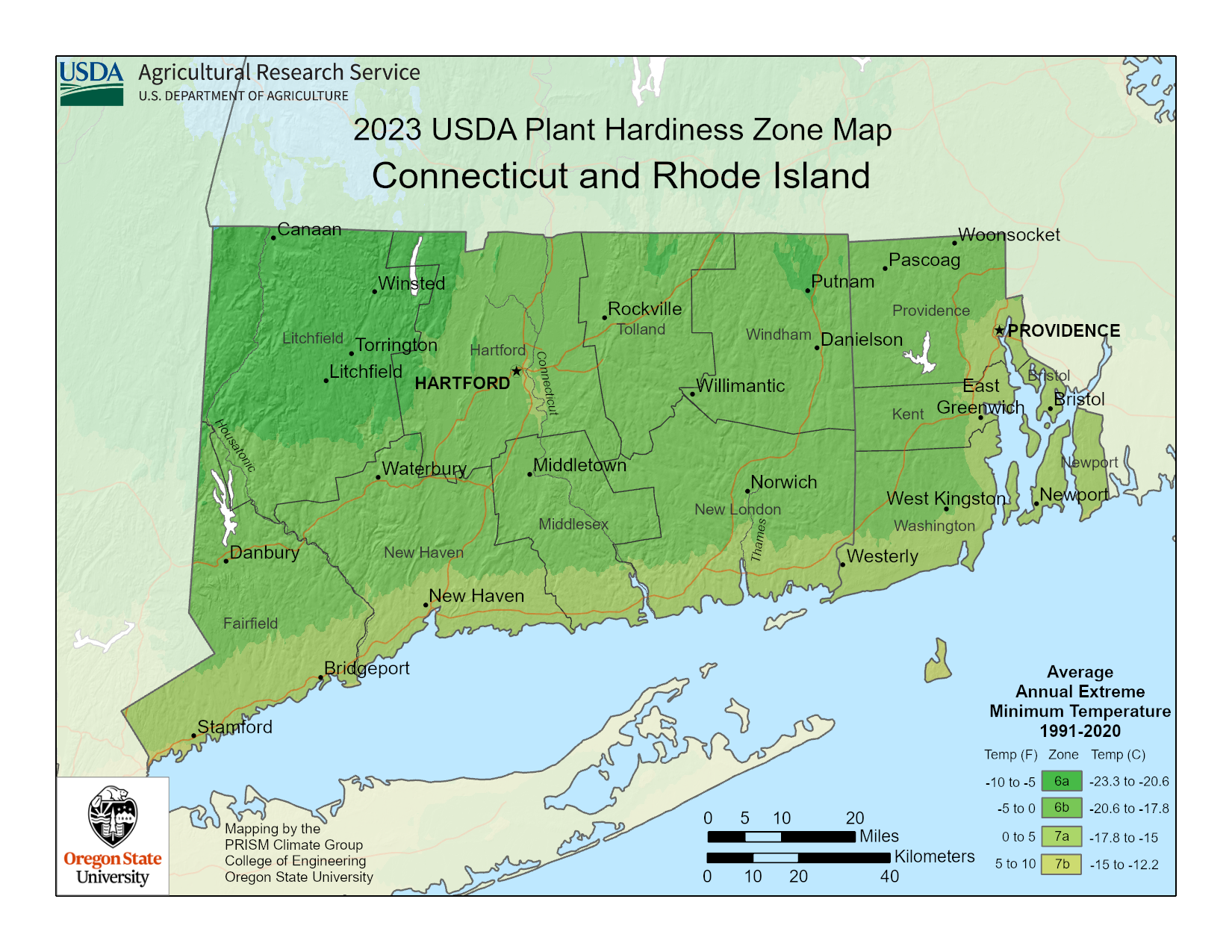Rhode Island Plant Hardiness Zones
| USDA Hardiness Zone | Average Minimum Extreme Winter Temperature Range Fahrenheit (°F) Celsius (°C) | Average Last Frost Date Range In Spring (Beginning Of The Growing Season) | Average t Frost Date Range In Autumn (End Of The Growing Season) |
|---|---|---|---|
| 6a | -10°F to -5°F -23.3°C to 20.6°C | Late April to early May | Early to mid-October |
| 6b | -5°F to 0°F -20.6°C to 17.8°C | Late April to early May | Early to mid-October |
| 7a | 0°F to 5°F -17.8°C to -15°C | Late April to early May | Mid to late October |
| 7b | 5°F to 10°F -15°C to -12.2°C | Early to mid-April | Late October to early November |
Rhode Island Growing Conditions

General Climate
Rhode Island plant hardiness zones range form 6a to 7b. Expect variable weather patterns from day-to-day as well as month-to-month in this state.
Rhode Island has three growing climates:
Humid Continental
The majority of the state falls into this climate category. A humid continental climate has four distinct seasons with cold winters. It has both hot and warm summer continental climates.
Humid Subtropical
The southern coastline experiences this climate. Humid subtropical climates have hot summers with cool winters. It has more rain than snow.
Oceanic
Block island (an island off the coast of Rhode Island) has an oceanic climate. The area experiences cool to warm summers and mild winters.
This climate is moderated by the proximity to the ocean. Wind patterns moving in from the ocean create a moderating effect on temperatures. This means that weather patterns aren’t as extreme and generally it’s mild year round.
Microclimates
USDA plant hardiness zones are an important starting point for your garden, but you’ll also need to consider microclimates.
Microclimates are areas where specific conditions create a climate different from the climate they’re situated in.
Buildings, fences, paved areas, or short hills and valleys can create these microclimates.
They can be as small as a space in your backyard or as large as a city.
In other words, learn about your local conditions from local experts to see if your garden falls into a microclimate.
Extreme Weather
Tropical Storms
Due to the proximity to the Atlantic Ocean, Rhode Island experiences tropical storms and hurricanes. These extreme weather events bring stormwater challenges, including:
- Rising water level
- Salinity which affects fresh water
- Erosion
- Degradation of shorelines and wetlands
One way you can mitigate the damages of these issues is to include coastal plants in your garden. These plants tolerate saline soil and wet roots.
Planting gardens also helps with soil structure, thus decreasing the chances of erosion. Gardens absorb excess water, and create habitat for birds and insects that may be displaced due to shoreline and wetland degradation.
Nor’easters
Nor’easters are storms created by cold north east winds moving in from the Atlantic Ocean. Hence their names. These storms bring strong winds, below freezing temperatures, rain, and blizzards. These types of storms are common in Rhode Island from November to April.
Prepare your garden in the fall to mitigate against these nasty winter storms.
Mulching the garden protects delicate plants that might not be as tolerant to hard frosts and cold winds. Think of this as tucking your plants into bed each winter!
Greenhouses are also a great way to extend your growing season and provide respite to plants all winter. Plants like winter kale, lettuce, and parsley do well in a greenhouse throughout the winter months.
Growing Season
Rhode Island plant hardiness zones frost-free days average from 155 to 180 each year.
The southwest has the shortest growing season with an average of 130 to 145 days. Areas along the coastline have the longest growing season with an average of 200 days or more.
Rhode Island Gardening Tips

Growing For Climate Change
Rhode Island plant hardiness zones faces many changes in weather patterns due to ongoing climate change. Some of these changes include:
- Erratic weather patterns
- Higher precipitation
- Severe storms
Rhode Island sees coastal storms worsening, sea levels rising, and prolonged droughts becoming more common.
Here are some tips for gardeners that live in areas that experience major flooding, live close to riverways, or are near eroding shorelines.
Stormwater Management
Follow rain garden design principles. Elements of this include digging a deep pit and filling it with different gradients of rocks. You can also put drainage pipes into these garden beds. This helps dissipate excess water and control water flow.
Use this if you live in an area that experiences major flooding or are close to riverways or shorelines.
Water Tolerant Plants
Choose plants that develop deep root systems and enjoy having their feet wet. They absorb high amounts of water and can help remove any excess stormwater runoff. Willows are great at this job. There are a lot of varieties of willows to choose from like weeping or variegated leaves!
An excellent perennial flower that doesnt mind wet soils is the cardinal flower. This flower mitigates against storm runoff by thriving in moist areas. It also attracts and supports pollinators, like butterflies, and hummingbirds!
Eroding Shorelines
Make your plant selection based on plants that develop strong root systems. Planting a diversity of plants will also help to build strong soils. These plants develop tight root systems that hold soil together.
Here are some examples of plants that are native to Rhode Island. Working together, these plants help create structured, healthy shorelines.
- Northern bayberry
- Beach grass
- Beach pea
- Seaside goldenrod
- Bearberry
- Beach plum
- Aster
- Yarrow
Pruning Trees And Woody Shrubs
Pruning trees and woody shrubs is an important factor in optimal health. Every woody plant has specific pruning requirements so make sure you look up the rules specific to your plant’s needs.
But it’s good to follow these general rules:
What To Prune?
A good rule of thumb is to remove any dead and wayward branches.
Branches rubbing on each other or facing inward should also be removed.
When To Prune?
Knowing when is the best time to prune guarantees success.
Avoid heavy pruning in the middle of the summer. This causes unnecessary stress when it’s hot and can lead to disease.
Generally, hard prunes are done in the winter when the trees are dormant.
How Much To Prune?
It’s important to only remove 1/3rd of the tree or shrub. Removing more causes the plant to become stressed.
The idea of pruning is to create enough airflow for “a bird to fly through it”. This also mitigates against mildew and other fungal diseases.
Consult With Local Professionals
Consulting with local gardening professionals allows you to benefit from their experience with your area’s conditions, the plants that do well there, and overall best practices.
Rhode Island Plant Suggestions

Trees
- White Birch (Betula papyrifera)
- Atlantic White Cedar (Chamaecyparis thyoides)
- Pagoda Dogwood (Cornus alternifolia)
Shrubs
- Coastal Pepperbush (Clethra alnifolia)
- Button Bush (Cephalanthus occidentalis)
- Silky Dogwood (Cornus amomum)
Flowers
- Blue Cohosh (Caulophyllum thalictroides)
- White Turtlehead (Chelone glabra)
- Spotted Wintergreen (Chimaphila maculata)
Vegetables
- Artichoke (Cynara cardunculus)
- Cauliflower (Brassica oleracea)
- Cucumber (Cucumis sativus)
Herbs
- Pagoda Horsemint (Blephilia ciliata)
- Bee Balm (Monarda fistulosa)
- Virginia Mountain Mint (Pycnanthemum virginianum)
Spices
- SpiceBush (Lindera benzoin)
- New Jersey Tea (Ceanothus americanus)
- Chives (Allium schoenoprasum)
Fruits
- Black Huckleberry (Gaylussacia baccata)
- Red Mulberry (Morus rubra)
- Black Raspberry (Rubus occidentalis)
Succulents
- Eastern Prickly Pear (Opuntia humifusa)
- Hedgehog Cactus (Echinocereus)
- Ball Cactus (Coryphantha vivipara var. vivipara)
Disclaimer
Any of the above can change and is not exhaustive.
Treat anything above like a good starter guide. Then use that as a foundation as you consult with local gardeners, professionals, forecasts, guides, and organizations.

